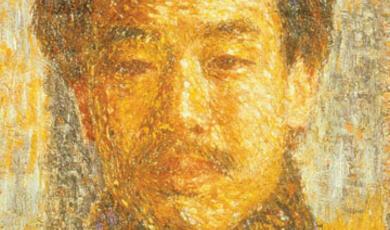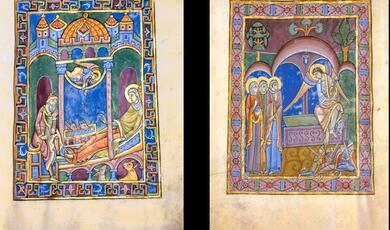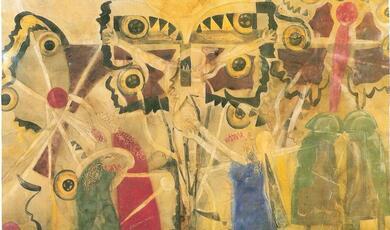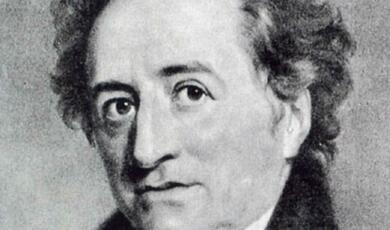How Folktales Contributed to the Confucianisation of Korea: Mother Green Tree Frog and her Children
Share
- Details
- Text
- Audio
- Downloads
- Extra Reading
Through an examination of selected Korean folktales, the lecture will illustrate how traditional society was influenced by Confucian values and how in turn folktales reinforced the values of Confucianism in society.
A brief overview will be provided of Confucian values as established in Korea, as well as an analytical framework for examining folktales. Five tales still popular in contemporary Korean culture will be discussed.
Download Text
13 November 2014
How Folktales Contributed to the Confucianisation of Korea:
Mother Green Tree Frog and Her Children
Emeritus Professor James Grayson
1. Introduction
Folktales are that part of the oral folklore of a people which are neither fantastic in the way that myths are in their depictions of the lives of gods, nor pseudo-historical in the way that legends are. They are tales of the purist fantasy with their depictions of talking animals, improbable events, acts of magic, and thrilling and blood curdling adventures. Often called ‘fairy tales’, they are popularly seen as just ‘fun’ to listen to but lacking in any serious content. However, folktales usually have a very serious purpose or function in conveying important cultural ideals, concepts and beliefs, but doing so in a way which is amusing, palatable, and memorable that a ‘serious’ statement might not be.
2. Functions of Folktales
Folklorists, anthropologists, and ethnographers have long been aware of the role which folktales have in the formation and maintenance of cultural values, addressed to both children and adults. The American anthropologist William R. Bascom (1912 – 1981) in the early 1950s wrote an article, ‘The Four Functions of Folklore’, which became the classic statement of the role of folktales in value formation.[1] The four functions he outlines are 1)‘Amusement / Entertainment’, 2) ‘Validation of Cultural Values’, 3) ‘Education of the Hearer’, and 4) ‘Conformity to Cultural Norms and Patterns of Behaviour’. These functions are not mutually exclusive, but are found in various combinations in all folktales. Thus the core theme of a particular tale may stress a particular cultural value (validation) in an entertaining way (amusement) while illustrating both why the value is important (education) and what happens if the hearer doesn’t adhere to that value (punishment for non-conformity). In reviewing the range of oral folklore in Korea and the other nations of East Asia, I have argued that while Bascom’s typology is very useful there is at least one other function, namely ‘Social Criticism’.[2] Thus a tale could be entertaining to listen to (amusement) while both making a trenchant social or political critique (social criticism) and, curiously, affirming certain core cultural values (validation).
In this talk I will look at four well-known Korean folktales to illustrate how these tales affirmed Confucian social values, even in the case where they appear superficially to be about adventurous or thrilling events. This process I refer to as the ‘Confucianisation’ of Korea, how the core values of Confucian social philosophy were transmitted and maintained over centuries, making Korea perhaps the most Confucian of all East Asian societies.
3. Analysing Folktales
When analyzing the oral folklore of a culture, there are a number of ways in which folktales have been examined. I use an approach which I call ‘Dramatic Structural Analysis’.[3] Looking at a folktale as a whole, ‘Dramatic Structural Analysis’ treats a tale as if it is a drama with acts and scenes. For comparative purposes, regardless of differences in type of actor or background scene, if the narrative of a tale proceeds with the same set of acts in the same order with the actors doing the same things, then the tales are the same or a similar tale type. In this talk, I will examine the dramatic scenes within four Korean folktales to see in what way they reflect Confucian values, and how in doing so they display one or more of the functions of oral folklore as outlined by Bascom.
4. Korea and Core Confucian Values
The socio-political philosophy of the seminal East Asian philosopher called Confucius (孔夫子, 551-479 BC ) in the West is principally found in a work of his collected sayings and teachings known as the Lunyu [Korean Nonō, 論語] or the Analects of Confucius. Although principally about governance, Confucius’s teaching begins with an analysis of society and the moral values which bind society together. In his view there are five principal social relationships in which all members of a society participate, that is, 1) the relationship of the ruler to the governed, 2) the parent to his/her child, 3) spouse to spouse. 4) sibling to sibling and 5) friend to friend. These relationships are dyadic (involving two people), mutual (the relationships are socially binding and carry mutual moral responsibilities), and hierarchical (differing levels of mutual responsibility). The types of mutual responsibility within these social relations are characterised by three core moral values, viz, 1) in [Chinese, ren, 仁] or ‘benevolence’, 2) hyo [Chinese xiao, 孝]or ‘filial piety’, and 3) ch’ung [Chinese chung, 忠] or loyalty.[4] ‘Filial piety’ and ‘loyalty’ are very similar virtues, and hyo may be taken to be a particular form of loyalty focused on one’s parents. In each of the four tales introduced in this lecture, we will look at the actors in the tales and how they display one or more of these Confucian moral values.
Although the ancient kingdoms of Korea had absorbed Confucian thought since at least the fourth century, and had created Confucian political systems of governance from at least the sixth century, it was not until the fourteenth century that Confucian moral values began to have a significant impact on the general populace rather than on the élite sector of society. The Chosōn dynasty (朝鮮,1392-1910) pursued a radical policy of the Confucianisation of all levels of society. The folktales recorded here reflect the three core values of benevolence, filial piety, and loyalty which were emphasized by government policy, law and custom. One way in which these values were inculcated was through the creation of village covenants [hyangyak, 鄕約] binding members of a village society to adhere to Confucian social morality. The four tales given here reflect the ethos of those covenants, and were a specific means by which those values were transmitted.[5]
5. Four Korean Folktales[6]
A. Why The Green Frog Croaks
Long ago in a certain place, there were some green frogs. The green frogs were famous for being unfilial. If their parents said go to the east, they went to the west; if they said to go to the mountain, they went to the plain; if they said to go the plain, they went the mountain. From the first to the tenth, they all were insubordinate to their [parents’] words and did exactly the opposite [of what they were told].
One day, mother became ill and was about to die. Mother called her frog sons together and earnestly entreated them as her last words, ‘When I die, don’t bury me on the mountain; bury me on the river bank.’ Because the green frogs always did the opposite [of what they were requested to do], if they were asked to bury [her] on the mountain, they would bury [her] in the end by the river. Therefore, her death wish was that they must bury her by the river so that they would bury [her] on the mountain.
As soon as mother died, the green frogs regained their senses. [The green frogs] thought that, because of their unfilial actions they had made [their mother’s life] miserable, shouldn’t they keep her death wish? Saying that this time they must listen to [mother’s] words, they built a tomb by the riverbank. After that, if the weather were foul, or if rain fell, the green frogs worried that their mother’s tomb would slide [into the river]. That is why when it rains the green frogs cry sadly.[7]
Structure and Commentary:
This simple and amusing tale has a three-fold dramatic structure - 1) an entertaining story about how the young green tree frogs were very unfilial children by making their mother’s life miserable, 2) the realisation by their mother that she was near death. Wanting to have a proper ‘Confucian’ burial in a mound on a hillside, she asks her children to bury her by the riverside, believing that they will do the opposite of her request and bury her on a hillside, and 3) the scene of the repentance of the young green tree frogs who then decide to be filial children now that their mother is dead and to bury her according to her stated wishes. This leads to ongoing misery for them.
This tale give a clear and unambiguous validation of cultural values. The narrative of the tale presupposes that Mother Green Tree Frog has acted with in or benevolence to her children, which is not reciprocated as it should be by filial piety (hyo). The narrative of the tale presents the hearer (a child?) with a story which says that if frogs have a society with ‘civilised’ values, how much more should young children observe the rules of propriety and listen to their parent’s wishes. The narrative also illustrates the function of what happens if you don’t adhere to the moral code. The young tree frogs’ repentance after their mother’s death only leads to continued (eternal?) psychological punishment for not being filial. They weren’t filial in their mother’s lifetime, and they can’t be properly filial now after she is dead. The function of punishment for non-conformity is continued stress and worry. There is also the function of amusement in this tale because we (the hearers) know what the young tree frogs should do, why don’t they? There is also an educational aspect of the tale, which in this case is an aetiology, explaining why green tree frogs croak, and has the additional effect of re-inforcing the value of filial piety
B. The Squirrels’ Gratitude
A poor, old couple lived alone without any child. One day, they save a squirrel from a weasel and took the squirrel home to take care of it. Many years passed. The number of squirrels had increased greatly, making it difficult for the old couple to take care of them all. The couple asked the squirrels to go out [to get their own food], and the squirrels obeyed. Each squirrel brought back a grain of rice. The squirrels kept bringing rice for the old couple until they died. When the couple died, the squirrels held a funeral for them and went back to the mountains.[8]
Structure and Commentary:
This tale is simpler in its narrative compared with the ‘Tale of the Mother Green Tree Frog’; nonetheless, it makes much the same point in a less elaborate way. The three scenes are 1)
a childless couple showed compassion on a squirrel by rescuing it from harm and raising it as if it were their own child; 2) the squirrels understand and appreciate the ‘benevolence’ [in] of the elderly couple, and consequently support them in their old age [loyalty or ch’ung]; and 3) upon the death of the couple the squirrels give the couple a ‘proper’ (= Confucian) burial and an appropriate (‘Confucian’) funeral ceremony.
This tale validates the moral values of hyo (filial piety) and ch’ung (loyalty) by saying that the squirrels listened to what the elderly couples told them to do, by caring for them when they were old, and by burying them and giving them a proper funeral. This tale tells the listeners (children?) that if squirrels are able to demonstrate the ability to follow these Confucian moral values, so too should the hearers. There is no obvious aspect of amusement (other than a tale about animals), no indications of punishment for non-conformity, and nothing which is educational in an aetiological or etymological sense.
C. The Brothers Hŭngbu and Nŏlbu
Long, long ago, there were two brothers. The older brother was called Nŏlbu, and the younger [brother] was called Hŭngbu. The older brother, despite being very rich, was an extremely greedy and vindictive man who constantly caused trouble for his neighbours. On the other hand, his brother was poor, but very kind-hearted. [Hŭngbu] was a very hard worker, but for some reason he didn’t have much luck. His wife and children knew no days but hungry ones. They led a very pitiable life.
One day, just after Hŭngbu had returned from work, a snake appeared and began to attack a swallow’s nest. The swallow and almost all her young were eaten alive. Only one young swallow narrowly escaped death. Even still, the young swallow had been injured. When it was fleeing, its leg had got caught in a bamboo blind and it had fallen to the ground. Seeing this, Hŭngbu quickly brought some ointment and rubbed it on the swallow’s wounded leg. Then, he carefully wrapped some string around it to give it some support. Then he carefully placed the young swallow back in the nest. In due course, the day came for the swallows to fly south. The swallow at Hŭngbu’s house, now fully recovered, flew off in fine spirits. In due course, winter passed, spring came, and it was the third day of the third lunar month. The swallow which Hŭngbu had helped also flew back chirping cheerfully. Hŭngbu was delighted. Then the swallow dropped a gourd seed on the ground. Thinking that this was strange, Hŭngbu picked up the seed and planted it in the ground.
After a few days, the seed began to sprout. The plant began to grow at a great rate. It pushed forth leaves and flowers, and eventually it bore five large gourds. Realising that they were indeed wondrous gourds, [Hŭngbu] consulted with his wife about what they should do. ‘Those gourds are many times larger than regular ones. Maybe we should cut one open to see if there might be something inside’. No sooner had they cut open the gourd when rice began to flow out of the gourd. They filled five huge containers, but there was still lots remaining. They took another gourd and cut it open. This time, it was gold which flowed out in large quantities. Hŭngbu and his wife danced with glee. Taking the third gourd, they cut it open. This time, a beautiful nymph appeared. Looking at the two remaining gourds, she said, ‘Come out! Come out red and blue bottles! Come out!’ With that, one of the gourds rolled over by itself and split itself in two. A red bottle appeared from the centre of the gourd and announced, ‘Here I am!’ Then in the same fashion, the other gourd opened and a blue bottle appeared. Then the nymph said, ‘Now you must build a huge mansion here.’ No sooner had she said this, when out from the blue bottle came a number of carpenters. Then from the red bottle out came a large quantity of timber. In no time, [the carpenters] built a splendid house. Then everyone returned to [their places]. The nymph disappeared in a puff of white smoke into the blue bottle.
After that, Hŭngbu became a man of wealth. He and his family lived happily and wanted for nothing. However, when his elder brother Nŏlbu heard the news, he came immediately to Hŭngbu’s house. He demanded to be told how his younger brother had managed to become so rich in such a short span of time. ‘Hey, you! How on earth did you do it? It’s a miracle. Tell me now how you did it’. Hŭngbu told him all about the injured swallow and what had happened afterwards.
Hearing that story, Nŏlbu went home and decided that he too would gain great wealth. So, he immediately built a swallow’s nest and waited for a swallow to come and make its home there. Then it happened that one unfortunate swallow did come and hatched some baby swallows there. In due course, Nŏlbu threw one of the swallows from the nest and broke its leg. Then he rubbed some ointment on the injured leg, wrapped it up with string, and placed the bird back in its nest. Winter passed and Nŏlbu’s swallow returned in the spring. [The bird] dropped a gourd seed in front of the waiting Nŏlbu. Nŏlbu immediately planted the seed. Things continued to happen just as Hŭngbu had described. Then, when the gourds appeared, Nŏlbu split open one [gourd] to see what was inside. However, out of the gourd came many little imps wielding sticks. ‘We must punish you for your greed’, they said and beat him mercilessly. Then the imps disappeared. Convinced that the other gourds contained gold, Nŏlbu struggled and managed to open another gourd. This time a large group of debt collectors appeared. ‘Give us money, repay your loans or we will take everything you have’. Eventually, they took everything and left. Nŏlbu, thinking that everything would be alright if he could just open up the other gourds, split open the third gourd. This time, a flood of dirty, smelly water poured from the gourd and deluged the house.
Nŏlbu couldn’t take anymore and ran to Hŭngbu’s house for help. His compassionate brother took pity on him and welcomed him warmly. The greedy brother reflected on his deeds and was very sorry for everything which he had done which was wrong. From then on, he became a very humble person. Hŭngbu divided his fortune equally with his brother and both of them lived happily ever after.[9]
Structure and Commentary:
This folktale is an example of a double contrastive narrative structure where the final scenes of the narrative are a complementary opposite of the first set of scenes. In this version of the tale there are five scenes. In the first scene we are introduced to the virtuous but poor younger brother and the greedy older brother. We see how the younger brother was kind (benevolent) in his actions, but his older brother was greedy and uncaring (not benevolent). In the second scene, we see how the younger brother’s benevolence extended even to the animal world (birds) and how he was rewarded generously for his virtue. The third scene shows us how the older brother’s greedy nature led him to commit an act of violence against the same world of animals which his younger brother had treated with kindness. The fourth scene shows us the punishment which was inflicted upon the greedy older brother. Some versions of this tale stop with these four scenes forming a perfectly balanced narrative of virtue rewarded and evil behaviour punished. This version has a fifth scene in which we see that the older brother repents and the brothers’ true relationship is restored. This scene further emphasises the younger brother’s benevolence.
This is a fairly complex narrative containing several assumptions about virtuous behaviour which are implicit in the story line without being expressed directly. However, we can note that there is a strong validation of the three core moral values. The narrative presumes that the elder brother is not living up to ideal ‘older brother behaviour’. His actions lack in (benevolence). He neither looks after his younger brother, nor does he provide a role model of Confucian virtue for him. The younger brother, on the other hand, displays model Confucian virtue in that he remains loyal and kindly disposed towards his older brother regardless of the treatment which he receives from him. In other words, the younger brother’s behaviour expresses ch’ung. By setting up two contrasting ideal characters, the narrative illustrates what good Confucian behaviour is. While the narrative clarifies what the virtues of in and ch’ung are, the narrative also enforces conformity to these moral values by illustrating what happens when they are followed and when they are ignored.
There is also an aspect of the universality of Confucian virtues in that the swallow (a non-human) rewards the younger brother for his acts of benevolence. The bird’s response to his benevolence may be seen to be an act of loyalty (ch’ung) and thus illustrates that Confucian virtues are practised by the human and non-human world alike.
The narrative contains a strong element of social criticism. There is a presumption in the story line, never explicitly stated, that older brothers look after their younger siblings and act as moral exemplars for them. The narrative is an implied criticism of older siblings who do not conform to Confucian moral virtue while lauding younger siblings who do. The fifth scene gives the real shock factor in the story – it is the younger brother who is the moral exemplar, not the older. Anyone hearing this tale for the first time would have been greatly shocked by the older brother’s behaviour. Instead, the younger brother provides the moral example, which eventually leads the older sibling to repent, and as a consequence, the proper relationship between the two is restored.
D. A Fight Between a Centipede and a Toad
Long ago, in a village there lived a poor mother and daughter. They were so poor that there were more times when they didn’t eat morning and evening meals than there were times when they ate morning and evening meals. One year, the rainy season was especially long. One day the rain was coming down especially strong. A toad came into the kitchen. The daughter had a feeling of loathing come over her and thought of putting the toad outside.
Even though he was a small creature, she took pity on him. She gave him some of the remains of their meal and raised him [as a pet]. Even though they were poor, they were not stingy. Because the toad was thankful that they gave him rice, he did not leave [their house]. The toad grew up to be quite healthy.
[One day,] when [the girl] got up in the morning, [the toad] seemed bigger than the night before. She thought that if the toad got any bigger he would be the size of a calf. Even though the toad ate more and more as he got bigger, the mother and daughter didn’t give the slightest indication that they disliked [the toad]. Every day without fail, they gave [the toad] some rice.
Behind the village there was a mountain. In this mountain there was an enormous centipede which had lived for several thousand years. Because the centipede had the power of bringing good fortune and of bringing rain, the villagers had built a shrine in the mountain and offered up rituals to the centipede. They firmly believed that if the centipede was properly propitiated, the harvests would be good, and that the woodcutters would be protected from attack by animals.
There was a custom that once a year there was a grand ritual at which a village maiden was offered up to the centipede. The maiden was thought of as the wife of the centipede and was not able to be married to anyone else. This particular year, the maiden who fed the toad had been selected to be the bride of the centipede. The maiden was very sad. Her future was dark.
Because she was to be the bride of the centipede, she would have to live a solitary life. The villagers felt that she had to do this because it was for the benefit [of everyone]. One couldn’t reject this custom, nor do anything about it. It was the day of the grand ritual. The villagers prepared the altar, and playing music entered in great numbers into the shrine. The maiden looked to her side without thinking.
The toad had followed her and was at her side. The girl asked the toad what she should do, but there was no response. The villagers left, and it became very dark. The girl was wrapped up in the dark and in fear. Because she was unhappy and terrified, her body began to shake. The toad was beside her and was thinking about what it had to do in the future. It became midnight. In the darkness, a strange sound arose and a centipede with countless legs appeared at the door. He had come to get the maiden. The girl’s body shivered all over. From the centipede’s eyes a green light shone. The centipede saw the toad and stopped. The toad which had seen the green light shining from the centipede’s eyes went forward in a strange way towards the centipede and began to fight it.
The centipede spat out poison, and the toad also spat out poisonous spittle. In the midst of the sounds of the mountain and the cries of the wind, the centipede and the toad fought to the bitter end. The maiden was so scared that she fainted.
The next day, the villagers gathered in front of the shrine. There was a strange scene all around. The centipede and the toad had fought, had drunk in poison and had died. The maiden was in a swoon. They woke her and gave her some gruel. The toad had repaid the maiden’s kindness by bravely fighting with the centipede and had died. The people of the village took the toad, placed it in a good spot and gave it a funeral. The centipede was burned in the fire. For the next three months and ten days it is said that the smell of the fire could be smelt all over the heavens.
As the centipede which the villagers had been afraid of for a long time was dead, the custom of offering up rituals to the centipede was abolished. It is said that because of this the custom of sacrificing a young maiden was also abolished.[10]
Structure and Commentary:
On the surface this complex tale would appear to be nothing more than a thrilling tale of adventure, the story of a young girl’s encounter with a ‘creepy’ beast in the darkest time of the night. While the creepy thrills are an important aspect of the tale, the point of the narrative is more profound than that. The narrative divides into four scenes. In the first scene, we learn of how the bond between a young girl and a toad was created and how it grew and deepened. In the second scene, we learn that there is a custom to sacrifice a young girl to a horrible beast, and that this year the toad’s patron was to be the victim. In the third scene, we experience the epic battle between the toad and the great beast, the giant centipede, and how the toad gave its life for the girl. The fourth scene is the denouement of the narrative as we learn that not only has the girl been saved through the sacrifice of the toad, but that the villagers abolish the custom of human sacrifice.
The rich narrative of this folktale exemplifies all five of the functions of folktales. The tale clearly validates the importance of benevolence, loyalty, and filial piety. The heroine displays kindness (benevolence) towards an animal which she initially finds disgusting but later comes to have an affection for. In turn, the animal (the toad) responds to this benevolence with unwavering loyalty – the willingness to sacrifice itself for its patron. To the hearer (a child?), the narrative says that if a toad could understand the ‘civilised’ value of loyalty to a superior and to be grateful for kindness, how much more should young children be able to understand this value. The loyalty of the toad to its patron in the narrative of the tale stands in for the filial piety (hyo) which the child should express to its parents.
The tale also illustrates the benefits to an individual who abides by the Confucian code of ethics (enforcement of conformity to cultural values). In the first instance, the girl who cares for the toad (benevolence) is rewarded by the toad’s sacrifice of its life for hers (loyalty). But importantly, the toad also benefits, if posthumously. The villagers recognising that the toad understood the value of ch’ung (loyalty) rewarded him by giving him a proper funeral. The story line is quite clear on this point. The villagers take his body, choose a (geometrically) proper site for his tomb, and give him a proper (‘Confucian’) funeral, just as if he had been a human. The narrative stresses the fact that the values of in and ch’ung are universal, applying equally to the animal as well as to the human world. Therefore, an animal abiding by Confucian virtues should benefit in the same way as a human would. The story line also says to the young listener, if society gives recognition to an animal who understood that loyalty is a core value, you too will be rewarded . As in the previous tale, the loyalty of the toad is to be understood to stand for be the filial piety which a child should express to its parents.
Like any tale of adventure, ‘A Fight between a Toad and a Centipede’ displays a high degree of entertainment value with its story line of creepy thrills. But it also displays the functions of education and social criticism. The story tells its hearers that ‘civilised’ people don’t sacrifice people to gods or horrible beasts (social criticism) and confirms this point by implying that they (the listeners) are ‘civilised’ because they don’t perform human sacrifice (education). The story line states that at one time there was this practice, but because of the loyalty of an animal for its patron (the sacrifice of its life), civilised practices were introduced which continue down to the present. In other words, the practice of Confucian virtues led to the creation of a civilised society (functions of education and conformity).
Concluding Thoughts:
This overview of four Korean folktales has shown that although any one of the tales may be said to be amusing and entertaining, even full of thrills in one case, this is not the principal function of any of them. In each of the tales, the Confucian virtues of benevolence, loyalty and filial piety are deeply imbedded. In the narrative of these tales, the core Confucian virtues are affirmed in the behaviour of the actors in the narrative, both human and animal, and the benefits and punishments which result from adherence or rejection of these virtues is clearly described. By the very nature of the way in which the themes of the tales are presented, the three core values are described as universal, applying equally to a human or an animal. And, these virtues are shown to be reciprocal in nature. Benevolence is responded to by filial piety, and acts of filial piety or loyalty are rewarded. Rejection of these virtues, likewise, has a negative result – punishment or loss of some kind. It was through the telling of folktales such as these that the three core Confucian virtues were introduced to young listeners, and were reinforced to the older listeners when they heard or retold them.
© Emeritus Professor James Grayson, 2014
[1] William R. Bascom, ‘The Four Functions of Folklore’, Journal of American Folklore v. 67 (1954), pp. 333-349.
[2]James H. Grayson, ‘They First Saw a Mirror: A Korean Folktale as a Form of Social Criticism’, Journal of the Royal Asiatic Society Third Series v. 16 (2006), pp. 1-17.
[3] James H. Grayson, Myths and Legends from Korea: A Compendium of Ancient and Modern Materials (Richmond, Curzon, 2001), pp. 3-6.
[4] For an introduction with textual material see Wing-tsit Chan A Source Book of Chinese Philosophy (Princeton, New Jersey, Princeton UP, 1963).
[5]For an introduction to Korean thought and religion see James H. Grayson Korea: A Religious History, Revised Edition (Richmond, RoutledgeCurzon, 2002).
[6]These four tales have been translated into English so as to remain close to the syntax and vocabulary of the language of the recorded story. In order to make a more comprehensible sentence, some explanatory phrases are enclosed in square brackets [ ].
[7]Original source: Im Tonggwŏn Han’guk ŭi mindam [Korean Folktales] (Sōul Sōmun-dang, 1972), p. 155. Translation in James H. Grayson Myths and Legends from Korea: A Compendium of Ancient and Modern Materials (Richmond, Curzon, 2001), pp. 256-257.
[8] Original source: Sim Ŭirin, Chosŏn tonghwa taejip [A Collection of Korean Fairytales] (Keijō [Sŏul], Hansŏng tosŏ, 1926), pp. 110-113. Translation in James H. Grayson Myths and Legends from Korea: An Annotated Compendium of Ancient and Modern Materials (Richmond, Curzon, 2001), p. 296.
[9]Original source: Ch’oe Inhak, Chōsen Mukashi-banashi Hyakusen [A Collection of Korean Folktales], (Tōkyō, Nihon Hōsō Shupan, 1974), pp. 193-197. Translation in James H. Grayson Myths and Legends from Korea: An Annotated Compendium of Ancient and Modern Materials, (Richmond, Curzon, 2001), pp. 322-325.
[10]Original source: Im Tonggwŏn Han’guk ŭi mindam [Korean Folktales] (Sŏul, Sōmun-dang, 1972), p. 121 – 122. Translation in James H. Grayson Myths and Legends from Korea: A Compendium of Ancient and Modern Materials (Richmond, Curzon, 2001), pp. 274-276.
This event was on Thu, 13 Nov 2014
Support Gresham
Gresham College has offered an outstanding education to the public free of charge for over 400 years. Today, Gresham College plays an important role in fostering a love of learning and a greater understanding of ourselves and the world around us. Your donation will help to widen our reach and to broaden our audience, allowing more people to benefit from a high-quality education from some of the brightest minds.


 Login
Login







